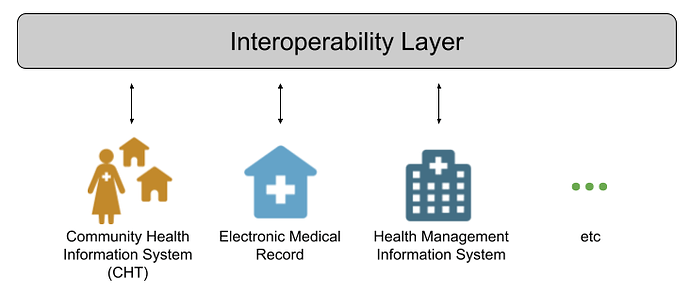Healthcare ecosystems are highly complex with many different actions being performed by a range of users, from the patient and caregivers, through to the Ministry of Health. Due to the wide range of use cases, no one software platform can meet all requirements, so instead multiple platforms are deployed together to implement different aspects.
Unfortunately this has caused health information to be siloed in discrete data stores. In some cases this leads to duplication of effort, for example, when entering patient visits in the CHT and then recording them again for reporting purposes. In addition, certain workflows are simply not possible without some sort of communication between these silos. For example, when health facility data is siloed, CHT apps can know when a patient has been referred to a health facility, but have no way to access the outcome of the referral or even if the patient showed up.
The issues of data isolation can be solved by integrating the various components of the ecosystem.
The current situation
Over the last few years the CHT community has developed a range of integrations to solve these issues on a case by case basis, for example, DHIS2 for reporting and RapidPro for messaging. This technique has been working well for projects in production but it does have some limitations. For example, these integrations can only integrate with those specified services, and development of new integrations requires updates to the CHT Core Framework.
Other CHT features give App Developers more options to configure integration, including OutboundPush to send CHT data to third-party systems, and CHT APIs to receive data from external sources. These integrations work well and are very powerful, however they can be hard to develop due to the unique characteristics of the external service. Furthermore, integrations like this often don’t scale well as more tools are added in the digital health ecosystem, and generally can’t be reused in another CHT project where different services and data systems are in use.
Enter interoperability
An alternative to direct integration between services is to use a Health Information Exchange (HIE). CHT apps adopting this approach can integrate with many other services that use the same interoperability layer. This allows CHT apps to be flexible about which services to integrate with, not just the services that have been built into the Core Framework. Ultimately this greatly simplifies data sharing, especially as healthcare ecosystems become increasingly complex.
The leading framework for interoperability in the digital health ecosystem is OpenHIE which outlines how to connect a wide range of services in their architecture documentation. OpenHIE also outlines roles for Components which are essential for helping services communicate.
The next step
Medic has been involved in a multi-organization research project to investigate the viability of bidirectional interoperability of the CHT using the OpenHIE framework and this work is ongoing to get this ready for production.
We’re actively looking to learn more about specific integration opportunities in the CHT community and explore opportunities for developing and deploying interoperability via OpenHIE.
What is your experience with integration? What challenges are you trying to solve? Are you interested in using OpenHIE for CHT interoperability in your system?

